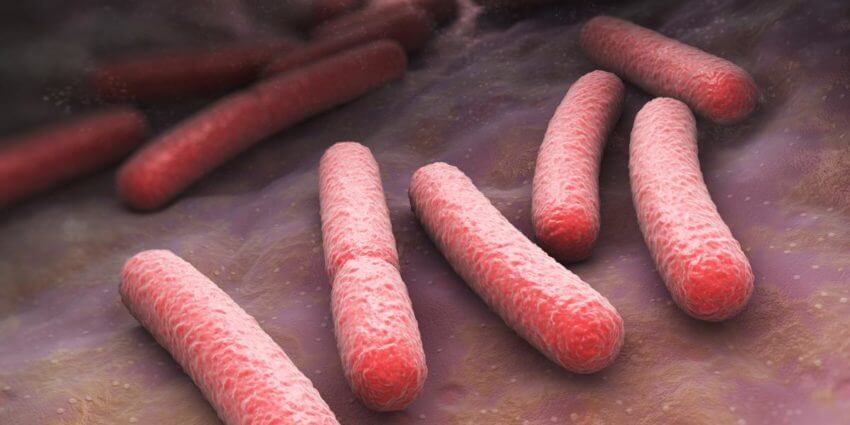Certain Escherichia coli (e.Coli) bacteria can be the primary cause of histamine intolerance or Mast Cell Activation Syndrome (MCAS) for many people. This bacteria can cause improper release of histamine in the body 24/7, the bacteria also releases an endotoxin called lipopolysaccharide (LPS). Histamine and LPS are the main cause of most symptoms associated with SIBO (even brain fog and hair loss!) and can even be the cause of a UTI. The following study appeared in The Journal of Immunology, it looked at mast cell activation in the intestine.
Mast cells (MC) respond to type I fimbriae protein, FimH, and lipopolysaccharides (LPS) from gram-negative e.Coli bacteria. What they’ve found is that not all e.Coli bacteria trigger histamine release, only “α-hemolysin (Hly)-producing E. coli strains induce the release of histamine”.
“We show that α-hemolysin (Hly)-producing E. coli strains induce the release of histamine, leukotrienes, and proinflammatory cytokines in intestinal MCs… This finding was surprising because it was demonstrated that murine MCs and human in vitro-developed MCs respond to type I fimbriae protein, FimH, via binding to CD48 and to certain TLR ligands including LPS” — http://www.jimmunol.org/content/181/2/1438
There are many possible causes for the improper release of histamine in the body. When the improper histamine appears to originate in the gut the underlying problem be related to bacteria, yeast, or even viral. However many people are finding that their underlying histamine problem is an overgrowth of certain e.Coli bacteria. This is especially true with a history of UTIs (which can be caused by a translocation of e.Coli from the colon to the bladder).
Certain e.Coli strains produce FimH and LPS 24/7 (even while you sleep); around 50% of e.Coli produce FimH, and even more produce LPS. This triggers your mast cells to release histamine (and other biogenic amines) in a non-effective attempt to kill the e.coli bacteria. Your body then requires DAO enzyme (produced in your small intestine) to neutralize the histamine. However, your body won’t be able to keep up with the demands for DAO and adding any exogenous histamine (e.g. from histamine containing food) will simply add to your histamine load. Thus you have bacteria producing histamine being released 24/7 and much of the food you eat is making the problem worse (by adding to the histamine load).
“E. coli Hly is essential for MC activation… E. coli Hly is produced by ∼50% of E. coli isolates causing infections at extraintestinal locations such as the urinary tract… E. coli is increased in patients suffering from inflammatory bowel disease as well as in IgA-deficient individuals (31, 32, 33). In those patients, the progressive breakdown of the mucus barrier leads to translocation of bacteria”
This really isn’t new concept, the above study simply adds to the knowledge of the underlying processes. There are dozens of studies on this very topic. The following is from 1994.
“the FimH subunit of the fimbriae or nonfimbriated E. coli, type 1 fimbriated E. coli induced mast cell degranulation in vitro… mast cells can be degranulated by interaction with type 1 fimbriated E. coli and that FimH, the mannose-binding component of the fimbriae, is a potent mast cell stimulant.” — https://www.ncbi.nlm.nih.gov/pmc/articles/PMC294203/
Other bacterial strains in the gut can also cause histamine intolerance, including Enterobacter, Staphylococcus, Proteus vulgaris, Klebsiella oxytoca and Klebsiella pneumoniae (as well as some yeast strains). However, e.Coli is the most common offender.
E.coli and Klebsiella release toxins that damage the intestinal lumen, this causes leaky gut. Leaky gut allows bacterial toxins (such as LPS) and histamine to enter the bloodstream. If there is no leaky gut these toxins usually just exit the body in the stool causing few symptoms. But leaky gut usually won’t get better until the dysbiosis is resolved (the bad bacteria are eliminated) and the microbiome starts to recover. Good bacteria produce short chain fatty acids (SCFA, such as butyrate) that heal the lumen and gets rid of the leaky gut. The good bacteria also helps to prevent bad bacteria from returning. So rebuilding the microbiome is essential.
The solution? I don’t think most people will make any progress with histamine intolerance (Mast Cell Activation Syndrome / MCAS) until they get rid of the offending e.Coli bacteria (or other opportunistic bacteria / yeast) and re-balance their microbiome. Once this been accomplished it can take time (several months to a year) for the gut to stabilize (as it has basically become neurotic and doesn’t know how to appropriately defend the gut for several months. This causes mast cells to over respond to minor threats / or even non-threats). DAO enzyme production will also have to be restored (I don’t have studies directly showing this but I think the cells that produce DAO become damaged by all of the inflammation caused by histamine. This takes time to heal). Several people in the book’s Facebook group have had their MCAS get much better, some have said “cured”, from re-balancing their microbiome.
Remember, it usually does no good to use broad-spectrum kill supplements / antibiotics. The offending bacteria are rarely 100% killed off and will simply repopulate the gut once it is left undefended (with most of the beneficial bacteria now dead). What you want is a much more selective kill process, a process that targets e.Coli bacteria (and other unwanted bacteria), while sparing beneficial bacteria, all the while building up the good bacteria. Thus The Gut Health Protocol.
Phage Complete is excellent at killing unwanted E.coli bacteria (strains that produce LPS!).
All images posted by John Herron are either "Copyrighted John Herron", or are copyrighted by someone else and are used under license. So please don’t use them elsewhere, you’ll get in trouble.


 Phage Complete comes with a full 30 day money back guarantee, for U.S. purchases this includes the original shipping charges to you!
Phage Complete comes with a full 30 day money back guarantee, for U.S. purchases this includes the original shipping charges to you!